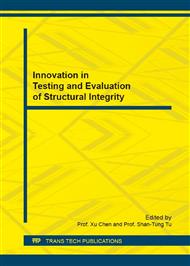p.3
p.8
p.15
p.22
p.28
p.33
p.41
p.46
Establishment of Unified Correlation of In-Plane and Out-of-Plane Constraints with Ductile Fracture Toughness of Steel
Abstract:
In this paper, the finite element method (FEM) based on GTN damage model was used to obtain ductile fracture toughness and investigate the establishment method of unified correlation of in-plane and out-of-plane constraints with ductile fracture toughness of steels. The unified constraint parameter Ap at different equivalent plastic strain (εp) isolines has been calculated and analyzed for SEN(B) specimens with a wide range of in-plane and out-of-plane constraints. The results show that the average Ap along the specimen thickness (Apave) can well characterize a wide range of in-plane and out-of-plane constraints. The suitable εp isolines range for establishing the unified correlation between Apave and ductile fracture toughness of the steel has been obtained. For the specimens with lower constraint, the higher εp values should be used. The results also show that the correlation line of JC/Jref-Apave1/2 is independent of the selections of the suitable εp isolines and the reference specimen. This may bring convenience for the establishment and application of the JC/Jref -Apave1/2correlation lines. Using ductile fracture toughness data of a small number of specimens with different constraints (such as three specimens with different a/W) together with FEM calculations of the parameter Ap, the correlation line of JC/Jref-Apave1/2can be established. The correlation line may be used in structural integrity assessments incorporating both in-plane and out-of-plane constraints.
Info:
Periodical:
Pages:
22-27
Citation:
Online since:
September 2016
Authors:
Price:
Сopyright:
© 2017 Trans Tech Publications Ltd. All Rights Reserved
Share:
Citation:


